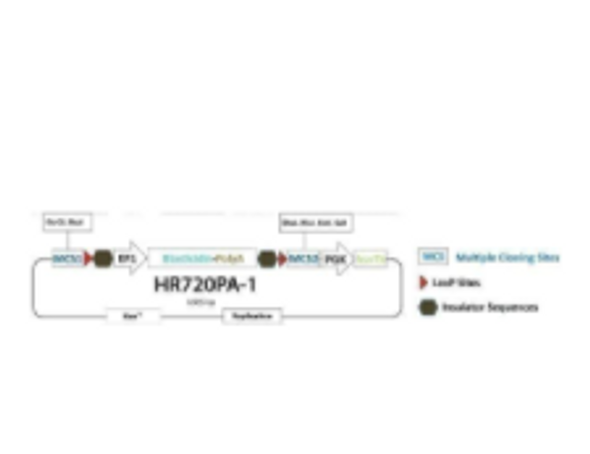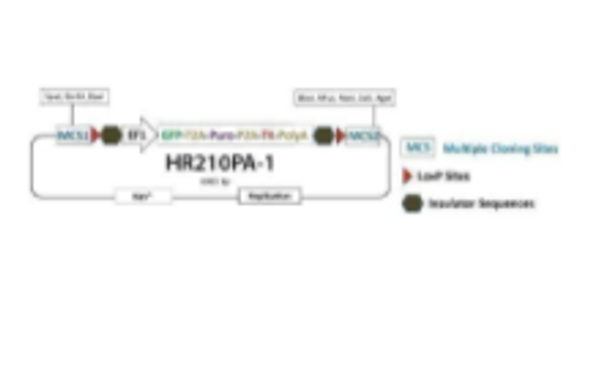System Biosciences
Gene Knock-Out HR Targeting Vector w/Dual Selection Markers (GFP+Puro) and Negative Selection (TK) Against Random Integration
- SKU:
- HR720PA-1
- Availability:
- Usually Shipped in 5 Working Days
- Size:
- 10 µ
- Shipping Temperature:
- Blue Ice/ Dry Ice
Description
Gene Knock-Out HR Targeting Vector w/Dual Selection Markers (GFP+Puro) and Negative Selection (TK) Against Random Integration. Cat# HR700PA. Supplier: SBI System Biosciences

Overview

. With on target HR Donor-mediated gene editing (left column), the homology arms of the HR Donor drive homologous recombination, resulting in insertion of only the region of the HR Donor that lies between the two homology arms—if the PGK-hsvTK cassette is outside of the homology arms, it will not be inserted into the genome and cells will not be sensitive to ganciclovir or fialuridine.
However, with off target insertion of the HR Donor (right column), integration is not mediated by homology, resulting in insertion of the entire HR Donor Vector. If the HR Donor includes the PGK-hsvTK cassette, even if the cassette is outside of the homology arms, the cassette will get inserted into the genome, rendering the cells sensitive to ganciclovir or fialuridine and enabling negative selection against off-target events.



| *All HR Target Vectors except PBHR100A-1 contain LoxP sites. Any sequences that are integrated between the two LoxP sites can be removed through transient expression of Cre Recombinase. **The clever design of these HR Donors enables enrichment for on-target integration events. A PGK-hsvTK cassette is included outside of the homology arms. Because of this configuration, on-target integration that results from homologous recombination will not include the PGK-hsvTK cassette—only randomly-integrated off-target events will lead to integration of PGK-hsvTK and resulting TK activity. Therefore, TK selection will negatively select against off-target integrants. Click on any one of these vectors to see a diagram of how the negative selection works. |
How It Works
At-a-glance—how to use an HR Targeting Vector to knock-out a gene

Figure 2. Knocking-out a gene using an HR Targeting Vector. Step 1: Cas9 creates a double-stranded break (DSB) in the genomic DNA at a site that is complimentary to the gRNA. Step 2: The DNA repair machinery is recruited to the DSB. In the presence of an HR Donor with homology to the region adjacent to the DSB (blue areas of the genomic and vector DNA) homologous recombination (HR) is favored over non-homologous end joining (NHEJ). Result: The HR event leads to insertion of the region of the HR Donor Vector between the two homology arms—your selection cassette is integrated into the gene, disrupting the open reading frame.
At-a-glance—how to use an HR Targeting Vector to edit a gene

Figure 3. Editing a gene using an HR Targeting Vector. Step 1: Cas9 creates a double-stranded break (DSB) in the genomic DNA at a site that is complimentary to the gRNA. For gene editing, this DSB should be within an intron. Step 2: The DNA repair machinery is recruited to the DSB. In the presence of an HR Donor with homology to the region adjacent to the DSB (blue areas of the genomic and vector DNA) homologous recombination (HR) is favored over non-homologous end joining (NHEJ). If one of the homology arms of the HR donor contains the gene edit, it will be incorporated into the gene through the HR repair process. Step 3: Transient expression of Cre recombinase will result in excision of the selection cassette, leaving behind a single intronic LoxP site.
Genome engineering with CRISPR/Cas9
For general guidance on using CRISPR/Cas9 technology for genome engineering, including the design of HR Targeting Vectors, take a look at our CRISPR/Cas9 tutorials as well as the following application notes:
CRISPR/Cas9 Gene Knock-Out Application Note (PDF) »
CRISPR/Cas9 Gene Editing Application Note (PDF) »
CRISPR/Cas9 Gene Tagging Application Note (PDF) »












![Gene Knock-Out HR Targeting Vector [MCS1-EF1a-GFP-T2A-Puro-pA-MCS2] Gene Knock-Out HR Targeting Vector [MCS1-EF1a-GFP-T2A-Puro-pA-MCS2]](https://cdn11.bigcommerce.com/s-i3n9sxgjum/images/stencil/590x590/products/12671/12936/sbi%2520system%2520biosciences_1633075021__00205.original__02911.1633076564.jpg?c=1)
![Gene Knock-Out HR Targeting Vector [MCS1-EF1a-GFP-T2A-Puro-pA-MCS2] Gene Knock-Out HR Targeting Vector [MCS1-EF1a-GFP-T2A-Puro-pA-MCS2]](https://cdn11.bigcommerce.com/s-i3n9sxgjum/images/stencil/590x590/products/12671/15641/Screenshot_2021-12-09_212928__74392.1639067413.png?c=1)
![Gene Knock-Out HR Targeting Vector [MCS1-EF1α-RFP-T2A-Puro-pA-MCS2] Gene Knock-Out HR Targeting Vector [MCS1-EF1α-RFP-T2A-Puro-pA-MCS2]](https://cdn11.bigcommerce.com/s-i3n9sxgjum/images/stencil/590x590/products/12673/12938/sbi%2520system%2520biosciences_1633075021__00205.original__03121.1633123705.jpg?c=1)
![Gene Knock-Out HR Targeting Vector [MCS1-EF1α-RFP-T2A-Puro-pA-MCS2] Gene Knock-Out HR Targeting Vector [MCS1-EF1α-RFP-T2A-Puro-pA-MCS2]](https://cdn11.bigcommerce.com/s-i3n9sxgjum/images/stencil/590x590/products/12673/15643/Screenshot_2021-12-09_214631__77660.1640262373.png?c=1)